On Curating Violence
A candid case study on the thorny issues that arise in curating around culturally and emotionally loaded subject matter: feminist representation(s) and performance tactics, curatorial ethics, and the place of risk, conflict, and even violence in performance.
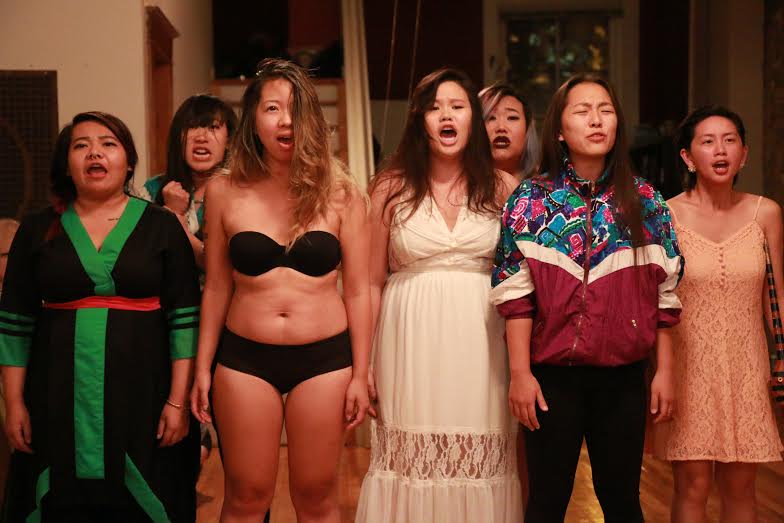
Contemporary performance makers maintain a deep intimacy with risk. Though descriptors like “risky” and “risk-taking” are overused in artist statements and press releases, this work involves a host of very real risks: the physical risk of injury onstage, the emotional risk of divulging complicated personal experiences, the social risk of speaking truth to power, the formal risk of contending with performance conventions, the relational risk of doing all of this in public. In late August 2015, my collaborator Billy Mullaney and I curated a shared evening of performance in our studio—an experience that drew together all of these types of risks and produced an unexpected conflict. This representational and personal conflict arose between two specific works, one by Magnolia Yang Sao Yia and the other by P. Collette, both of which grappled with violence against women. I decided to share this case study in collaboration with these artists, hoping that our conversations following the performance could shed more light on the issues it raised: feminist representation, performance tactics, curatorial ethics, and the place of violence in performance.
Mullaney and I, who work under the name Fire Drill, organized The Map Is the Territory on the occasion of Seattle-based theater artist Tim Smith-Stewart’s visit to Minneapolis. While we’ve curated shows around touring artists before, this was the first time that we curated an entire evening of works based on one specific piece. Smith-Stewart had sent us video of a previous incarnation of his work Awaiting Oblivion or How to be ok when everything is not ok—Temporary Solutions for surviving the dystopian future we find ourselves in at present, and we chose local artists who we thought might draw out some of the themes and forms we saw in that work, including anti-capitalism, feminism, utopian/dystopian thinking, experimental text, unreliable narrators, and documentary-style storytelling.
We wondered at the outset if such a thematically-focused show would create a narrow range of works, but the two works that were the most thematically related actually diverged widely in their political and performative tactics. We specifically invited these two (out of six total featured artists) because of their engagement with feminism: Yang Sao Yia, who works primarily with movement and draws on a wide range of dance forms, and Collette, who creates character-driven, text-based performances that often include burlesque. The conflict that arose between the two works in the performances of August 28 and 29, 2015 was not overt; indeed, many audience members were probably not aware of it. But for some, placing these two works in proximity to one another caused significant hurt and feelings of disempowerment. It also caused the cast of Yang Sao Yia’s piece to walk out of the performance space before Collette performed on the second night.
Preparing for this performance, we did request specific pieces from some artists that we thought were a good fit thematically, but we extended open invitations to both Collette and Yang Sao Yia to do whatever work they chose. While that practice is less common in visual art, I hear many performance curators pride themselves on commissioning artists instead of pieces, on the grounds that it gives greater autonomy to the artist and results in better work, because they can choose the work that serves their practice best. Prioritizing an artist’s practice is important to us, especially since we are not curators who are tasked with distributing resources and programming a season. Rather, we are fellow artists creating a space for works that may not have happened otherwise. The result of our open-ended invitation to these two artists—coupled with the show’s location in a low-tech space—meant we did not view the pieces until the first performance, and thus were not able to anticipate the conflict between the two works.
Yang Sao Yia’s piece Shhh…silence brought together a group of Hmong women to create dialogue about their shared experiences, especially around violence and patriarchy in their community. Yang Sao Yia was incited by Hmong TV anchor Doua Chialy’s misogynist comments on air this past July. She built a coalition of young women, some experienced and some new, to dance and to activism, including Ahne Her, Gaosong V. Heu, Itly Thayieng, Nplooj Siab Vaj, Holy Yang, and Prescillia Yang Sao Yia. The work sprang from a “visceral need to react, act, and respond to such violence.” Yang Sao Yia’s questions about body, representation, history, and agency drove the process: “What does it mean to fill the performative space with an unfamiliar body carrying an unfamiliar history and background? What does it mean to present the body as the actual body, as its actual representation? What does it mean to not represent for others, to represent yourself, and to take ownership and agency in your positionality?”
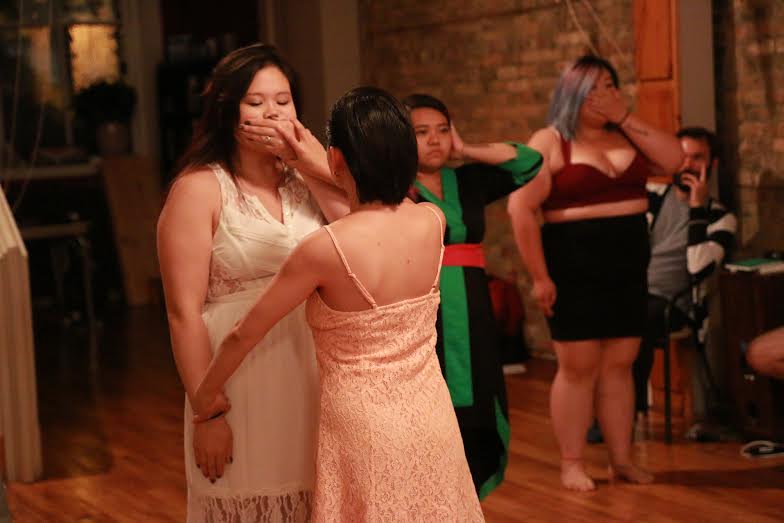
At the beginning of the work, the women stand grouped with their backs to the audience, and they begin to whisper. Their words are inaudible at first, but then one hears some fragments of sexist language: “You’re just a girl,” and, “Why are you dressed like that?” Their voices rise in volume together, building to a crescendo that is punctuated by a scream—a build and break that repeats later in the piece as well. The group moves forward into the crowd of viewers, making visible their range of personal clothing choices: a sleek button-down and jeans, a crop top, a track jacket, a bra and underwear, a modern Hmong dress. Gaosong V. Heu recites a poem of her own composition, which details and refuses the oppression of women. In a rich and clear voice, she begins: “For centuries, we have been silenced…” The group stands by with statuesque presence as Nplooj Siab Vaj performs a sequence of rhythmic footwork; then she repeats the movement while playing a corresponding melody on the qeej. In the final section of the work, the women break each other out of frozen positions with a gentle touch and a whisper: they stand with their hands covering their eyes, ears, or mouth, until one of their collaborators uncovers and replaces their hands. With each interaction, they say to each other either, “You don’t deserve this,” or, “You deserve this.”
Yang Sao Yia shares more about the tone and intentions of the work:
“The space that I had built was about creating dialogue about our shared experiences as Hmong women. It was about growth. It was about how to see, talk, approach, and respond to, and shame patriarchy. It was about recognizing violence. It was about discontinuing perpetuating violence. It was about building equity. It was about empowering our voices. And most importantly, the space created was about healing… Within this audience, I intended for them to feel our unapologetic presence and power.”
From the outside, this intention was clear and palpable: I saw tears throughout the audience, and felt the tone of the space profoundly transformed.
In the opening night’s performance, this raw, earnest, and visceral mood was broken sharply by a transition into the work that Mullaney and I programmed directly after it, Collette’s FOOD BLOG. Collette descends a staircase into the performance space in blonde wig, sunglasses, heels, retro suitcase, and striped umbrella. She moves through the crowd, greeting audience members and placing her red suitcase on a small table. In a Southern accent, she introduces herself as Mary Kay consultant Patricia Lake, eliciting laughter from the audience. In Collette’s own words: “I like that the Mary Kay detail potentially plants this little seed in an audience’s mind. Like, okay, we’re going to deal with femininity here. We’re going to deal with it explicitly, but we’re going to slip it in covertly—like getting someone to eat some spinach while they’re snacking on some creamy artichoke dip.” We sense that we’re in another world here: one where statements are layered with irony and meaning far beyond what you might take at face value. Collette’s over-the-top presentation of femininity is in the lineage of Karen Finley, Annie Sprinkle, Dynasty Handbag, and Ann Liv Young: “reckless, expressive women”—all of whom, I’d add, are also white. Collette also names Joan Rivers as an influence: “I genuinely believe that jokes are powerful tools, that laughter can be a doorway into inquiry and examination, and that entertainment is often an element in performance that invites an audience to be present, to show up, and pay attention.”
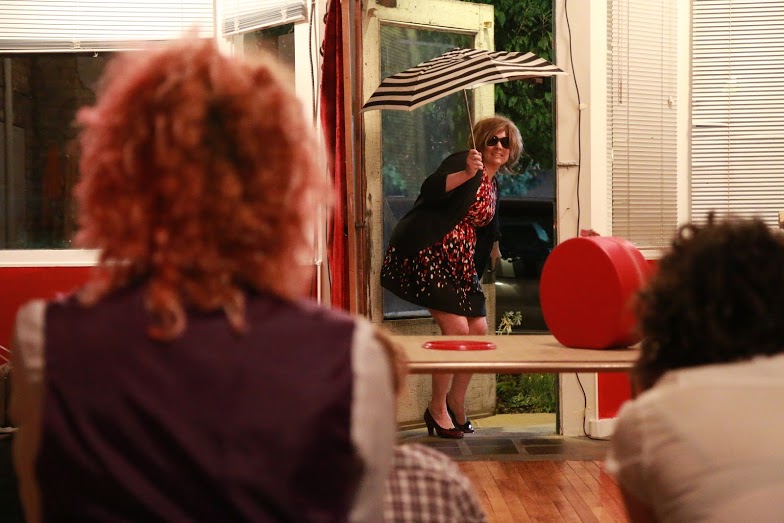
With a mock self-help, confessional tone, “Patricia Lake” regales the crowd with tales about the commenters on her food blog who come looking for recipes in times of emotional need and distress. She delves into her history of mental illness and the stigma around medication, declaring that “pills are the anal sex of mental illness”—i.e., a line some don’t want to cross. This character wants to normalize both: “Drink a bottle of wine, try again next week!” She addresses how the taboo has changed while setting up the next punch line: “It’s cool to talk about mental illness now. Didn’t always used to be that way. Certain things are cool now; other things are not. Like domestic violence. Used to be okay to beat your wife. Now, not so much. And I think that’s because of air conditioning. Like, can’t you imagine, back in the day, there’s a masculine figure, and there he is in a wife beater, you know those shirts? And I can just see him, and he’s getting so very hot and so very angry. But now: air conditioning! I think there’s a direct link between air conditioning and the drop in domestic violence.” Her monologue is punctuated by swigs of Jaegermeister from the bottle, and eventually she pulls an Arby’s bag from the suitcase, stuffing her mouth with roast beef sandwiches before passing fries around the audience.
Now that the crowd is warmed up, the tone turns darker. “Patricia” produces gummy worms from her suitcase and says she’s “been thinking about worms a lot lately. How they bury themselves in the earth and eat away at our dead flesh. But also how they can create new life. Like, you know how you can cut a worm in half—and then it becomes two new worms, with two new faces?” She’s also been thinking about a song called “Can’t Feel My Face” by The Weeknd: she wonders aloud why the speaker in the song can’t feel his face, and if that’s anything like the worm right before it’s been cut: “That brand new face, it’s gonna emerge so soon—but the worm just can’t feel it yet.” She continues, “Or is it like, you’ve just been hit by your lover. And maybe you’re having a sort of out-of-face experience. And you just can’t feel it.” Fewer audience members are laughing now. But “Patricia” is undeterred and proceeds to dance to the noted pop song in messy burlesque fashion. She rips off her wig and dress to reveal a white tank top, the kind sometimes called a “wife beater.” She kicks her heels off at the wall, pulls a large squirt bottle of ketchup from her suitcase, and directs an audience member to squirt it over her chest and face. Throughout, she continues to dance with verve, tumbling through the audience and rolling through her own mess.
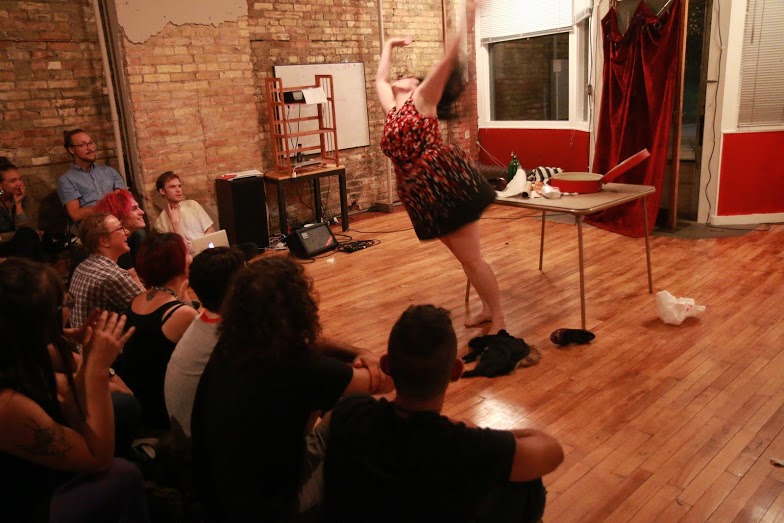
As the works unfolded, it was clear to Mullaney and me, as curators, that the juxtaposition of these two pieces, in particular, was rough. Collette also sensed this on the first night, asking me to cover for a moment before she began her piece, so she could modulate her performance energy to adjust the audience into a different context. After a phone conversation with Yang Sao Yia, we changed the order of the pieces for the second performance, providing time for the tone to shift between them.
I later asked Yang Sao Yia to describe in more detail how she and her collaborators reacted to Collette’s work:
“My cast and I just freshly experienced a journey that involved us digging through the deepest darkest places of our being in which consisted of gender-based violence, and, with much respect, aspects of mental illness in which we discussed as trauma. It was distasteful, disserving of our work, and hurtful to have our work placed alongside Paige’s performance. It re-disempowered our voices, undid the labor done, devalued and almost ridiculed our positionality by shaming us for voicing our hurt. What was most hurtful to me was seeing my cast slowly feel their power getting pulled away from them, as their lived experiences and hurt became jokes for others to laugh at, to provide entertainment for, and to consume. It may not have been Paige’s intention to cause this effect upon my cast and I, nor yours, but the reality is that it did. Good intentions do not always deliver good outcomes.”
She added that for the viewer, her “work could have only been experienced on a surface level” in such a context. I knew from earlier conversation with Collette that she was creating a piece based on deaths and trauma she experienced in her past two years living in North Dakota, so I assume that her portrayal of violence was intentional and personal, not flippant. In fact, she has written that the discussion of mental illness in FOOD BLOG is “something that stemmed from autobiographical experiences.”
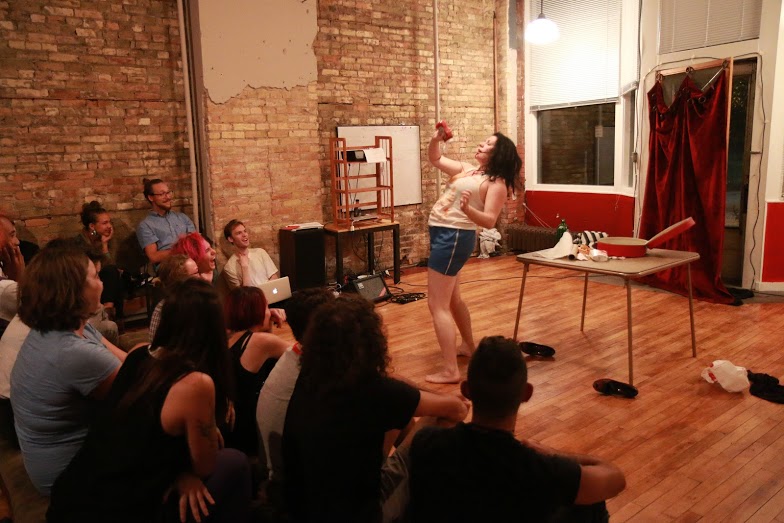
Regarding domestic violence in particular, she adds:
“I felt like I was just dipping my toe in. I saw ‘Can’t Feel My Face’ as a current piece of pop culture that was brushing up against violence, and I wanted to unpack that a little. It was never my intention to do a thorough examination of domestic violence. There are people close to me whose lives have been marked by domestic violence, and at this point I feel that those are their stories to tell, not mine. Domestic violence is something that’s affected both sides of my family, especially my grandparents, and that’s something I’ve only learned through conversations with my mom over the years. I just really felt intrigued by that pop song by The Weeknd, and I wanted to open it up—like a can of worms, I guess.”
She described her larger discussion of death and loss in the piece as similarly in process, not necessarily intended to end in healing or resolution, but instead a matter of starting to chew on it in a vulnerable, relational way:
“I don’t think I directly processed those losses in the piece at all. I wasn’t ready. And after two years of living in a very remote location with no nearby opportunities to share the type of performance that I usually find satisfying to make, I just felt that it was important for me to create and share a performance—period. I think that for me, the sheer act of performing my own work in front of an audience has the potential to be a healing experience—even though I often create disruptive performances. Sometimes I see the disruption as the catalyst for healing and catharsis. It also just provides an opportunity to engage in a heightened experience. With FOOD BLOG I don’t think that I was healing any specific wounds of loss from North Dakota (and the tragedies in North Dakota were not related to domestic violence). But what I chose to do was to approach the performance from a broader place of, ‘Hey audience-humans, being humans is hard, right? So as a performer-human, I’m going to try to process some of those difficulties, and then you’ll witness it, okay? Thanks, audience.'”
Collette has often presented work in queer performance spaces, so I associate her use of camp and drag aesthetics with that lineage. Yang Sao Yia also astutely pointed out the fractured identities at play in this type of work, which she described as a “removal of the self.” She observed:
“There was a difference in the contemporary work I presented, and the contemporary, possibly postmodern, work that was presented alongside mine. Postmodern aesthetics come to mind because much of what I saw and experienced was the removal of the self. That is what I feel set my piece apart and alienated it from the rest. My piece required so much vulnerability, of human emotions and the human self, that the transitioning of differences of aesthetics may have been discombobulating for audience members.”
While Collette’s work continually pointed out its status as performance, revealing artifice like the removal of a wig: she says, “I believe that sometimes when a performer steps away from themselves, it can create more space for an audience to be present.” Yang Sao Yia, on the other hand, commits her work to honest self-determination: “Nothing that was ‘performed’ in that space was truly performed. Our display was raw.”
From my vantage point as curator of the show, I see that both artists communicate a clear intentionality around “rawness:” Yang Sao Yia in self-representation, and Collette in process and the development of meaning. At the same time, both artists engage theatrical convention or choreographic structures to contextualize the living material at the heart of the work.
There may be an inherent conflict, even a violence, in the curatorial act of selecting artwork and placing it in a new context, in relation to other art objects that work did not ask to converse with. But the resulting conversations can be deeply generative, too, if difficult.
This curatorial case study is exemplary of the confluence of many histories: performance forms, identity formations, activist techniques, and social divides that are born out of multiple oppressions. In Collette’s and Yang Sao Yia’s works, I see divergent tactics and different assumptions about the body, the self, the text, and the viewer. Yet they share a resistance, and even combativeness, towards the status quo, specifically pushing against physical and representational violence towards women. I see an affinity in their work: they’re grappling with similar issues, albeit in different ways and from their own social location—though the artists themselves may not agree with my correlation.
The tension between these two works mirrors tensions within contemporary feminism, which have much to do with racial inequality. Although the hurt caused by this performance was certainly connected to race, and Collette’s and Yang Sao Yia’s feminist tactics grew independently, out of distinct social experiences, it’s important not to elide their performance strategies with their identities. Irony does not belong to white artists, and layered, highly constructed depictions of the self have been used to powerful effect by artists of color. It would also be false to position comparison of these works as a choice between representing the self “honestly” or “ironically:” rather, there is a wide range of critical and representational strategies artists may activate, and all of which take on different meanings in various social contexts.
These months later, I am left with many questions about the place of violence in performance. What responsibility do the artist and the curator hold when they take on that content, and what practices honor the vulnerability it entails?
When I asked Collette about the role of violence in her work, she identified it as working on several levels, from her body to representation:
“I like to explore boldly, recklessly, with food, with metaphors. I like to explore without a fourth wall. I don’t want to recreate realistic representations of violence; that’s what Law and Order is for. I like to explore these things imaginatively, in a world of fantasy… I like violence that is expressed through metaphor or violence that is the real result of physical risk onstage.”
In Collette’s work, transformation arises by physically inhabiting that risk. She explains via a quote by artist Janine Antoni: “The reason I’m so interested in taking my body to those extreme places is that that’s a place where I learn, where I feel most in my body. I’m really interested in the repetition, the discipline, and what happens to me psychologically when I put my body to that extreme place.”
On the other hand, Yang Sao Yia stated that she is “not interested in necessarily the aesthetic or performance of violence, but [is] more concerned in excavating and investigating truth, and depth from which violence has arisen from.”
There’s much to respect in both of these approaches. I wonder to what extent it’s necessary to represent violence in order to critique it; in so doing, it’s all too easy to reproduce the very images and dynamics one aims to repudiate.
Expressly dealing with violence also demonstrates the ways vulnerability is an inevitable facet of performance, for both viewers and creators. Every individual in the room carries different histories and defense mechanisms in response to both real and representational violences. As a society we are used to superficial displays of violence in mainstream media, but as artists we aspire to something more considered, less banal. Recognizing and processing one’s own vulnerable reactions is an integral part of artistic process. If we stick to methods that keep us comfortable, we remove the generative friction necessary for our form to grow. But what does that mean for individuals who are participating in art experiences, but who have perhaps not committed themselves to embracing such risk full-time? People have a right to feel safe, and particularly in an intentionally created space of performance, a sense of safety lends itself to a more open and thoughtful viewing experience. Especially in a time-based art form, we should develop our understanding of how these experiences play out over time and provide evidence of curatorial care (to borrow a phrase of Kristy Edmunds, used at the Walker’s recent New Circuits conference) that extends beyond the performance itself.
And yet I don’t think that the curatorial production of conflict is an altogether bad thing. From my own perspective as an artist, I tend to think that art may be better suited to creating rupture than healing, and that conflict can result in productive dialogue. On the level of representation, this means a break with formal or social convention, or argument with the status quo. This is not to say that healing is not a legitimate goal of performance; it’s just not my personal or creative priority, and my proclivity was certainly exposed in this event. There may be an inherent conflict, or even a violence, in the curatorial act of selecting an artwork and placing it in a new context, in relation to other art objects that work did not ask to converse with. Yet I steadfastly believe the resulting conversations can be deeply generative, if difficult, expanding our thinking and our relational capacities. I support the right for performance to be unsafe or disruptive, but if the people who feel unsafe are already the most marginalized—in this case, several women of color in a largely white room—then something is wrong with the equation. That, if anything, is what has left me the most unsettled after this show, and belies my own curatorial irresponsibility.
I wonder about how we could have better contextualized these two performances, their artistic lineages and their personal content. At the same time, I am wary of determining too much, of taking agency away from the viewer to define their own experience and interpretation. Audiences can usually tell when they’re being pandered to, and as a political choice, I want to assume the highest intelligence on the part of the viewer. I know this is derived from my own preferences as a viewer: I bristle when I perceive that I’m being educated somehow, or told what to think about a performance. Part of my own sense of empowerment—which I realize comes out of my experience as a white woman—is in my insistence that I don’t need to be protected. I like to think that when I go to see performance, I’m also consenting to deal with discomfort, fear, provocation, or offense. On the other hand, I do still make choices about what I want to submit to, based on what I know about the artist’s history, whether I feel like contending with all that’s required of me for participation on a given evening, and any number of other factors I can access as an educated viewer. Would I hold this view if I were a less frequent audience member, or if I experienced more social marginalization? Perhaps not.
In most performance venues in the Twin Cities, we only see content warnings for things like nudity, stage fog, gunshots, strobe lights. I roll my eyes at those signs because, aside from legitimate health concerns, they often read like antiquated moral warnings; they don’t speak to the actual dangers and vulnerabilities of live performance. Gender-based and racial violence do not tend to warrant content warnings, perhaps because both are so pervasive in our daily lives. We do know of a few curators that offer safety statements outside the Twin Cities, such as Smith-Stewart’s own series Birthday Girl, whose safety statement specifically forbids “hate, violence, and bigotry.” Oakland-based feminist collective SALTA took a more contingent approach for a recent event: “We want to engender a space where accessing and processing things that may be intense or triggering can be collectively inspiring and therapeutic. We want to try to create a safe space to exorcise these feelings—we wonder whether safe spaces actually exist (and for whom).” In SALTA’s language, I see an understanding that violence might need to be represented in order to confront it, and a recognition that even intentionally safe spaces often reproduce social inequalities.
Was it negligent for us not to provide a content warning for this performance? Perhaps. For the developing field of performance curation, and in the spirit of generative conflict, I offer these statements to retroactively frame the confluence of these two performance works:
- Contemporary performance navigates physical, emotional, social, formal, and relational risks using a wide range performance strategies.
- The violence and inequality that are pervasive in everyday life reproduce themselves in the space of performance, without specific strategies to combat them (and often even with those strategies).
- Low-budget and no-budget artist projects are not exempt from developing those strategies.
- We trust artists to navigate their histories and communities, whether creating works that are deeply considered or still in formation.
- We trust viewers to interpret performance works through their own frames, responding with critique when necessary.
- Lived experience and performative representation share a close relationship, which may or may not be made explicit by the performance forms.
- Violence and safety are not always mutually exclusive, and they often occur in unequal measures in the same spaces.
- The curatorial act of juxtaposing artworks carries an inherent conflict in that it reframes the artists’ intentions.
- That conflict may detract from a constituent work’s impact and/or produce a generative conversation.
- The conditions that produce agency are not found in a simple prescription or a single path, but develop in context into multiple forms.
Thanks to the artists for sharing their work and post-performance reflections, and to Billy Mullaney and Sarah Welch for working through the analysis with me.